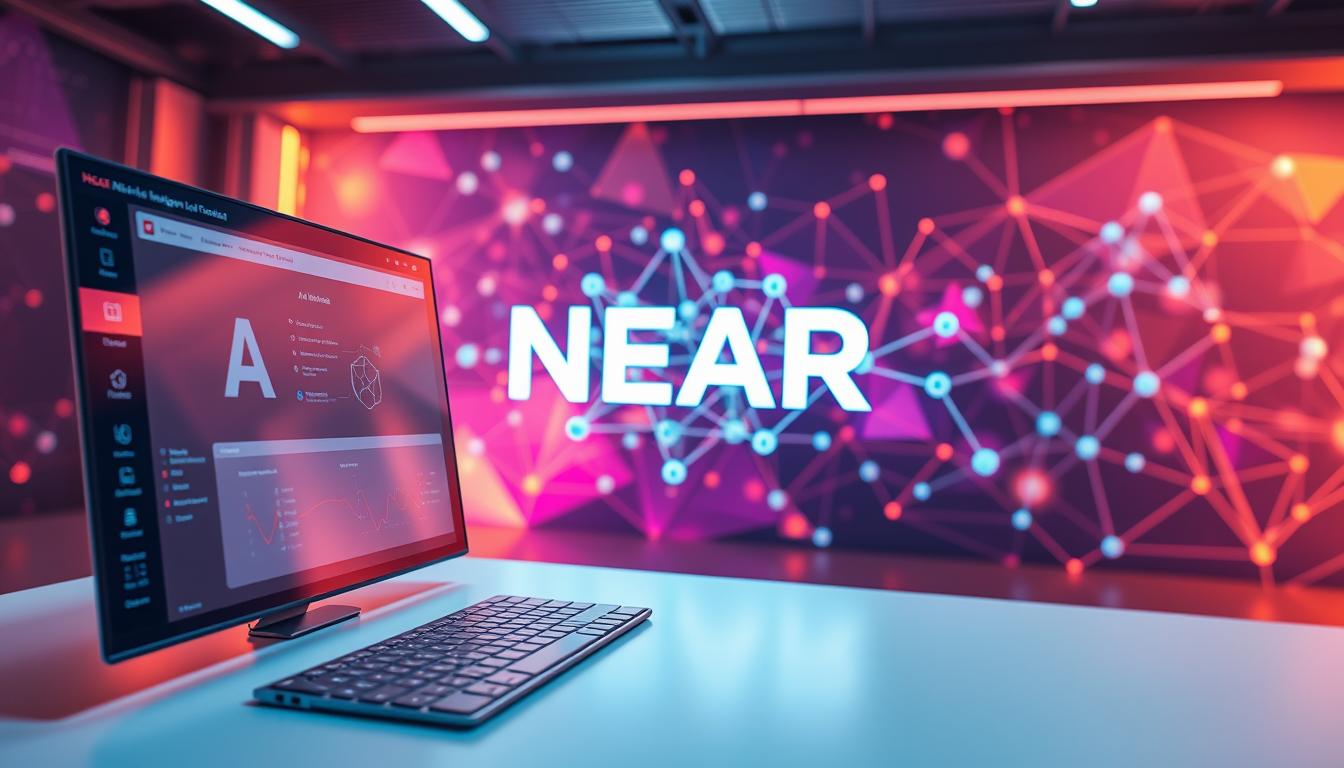Now Reading: NEAR protocol artificial intelligence development platform Explained
- 01
NEAR protocol artificial intelligence development platform Explained
NEAR protocol artificial intelligence development platform Explained

This section introduces a practical foundation for AI‑native applications that need dependable blockchain guarantees and a modern developer experience for US enterprises.
Think of the stack as two parts: a user-facing AI layer that guides intent and a secure backend that handles identity, trust, and data. The chain acts as the execution bed so agents can own assets, make decisions, and transact across networks.
The architecture uses Nightshade sharding and Doomslug consensus to deliver sub-second blocks and ~1.2 s finality. That design keeps fees low and throughput reliable for real users and enterprise applications, while wallets and tokens enable smooth commerce across the world.
Built for the future: mature tooling, education programs, and production services speed time-to-value. Services cover discovery, architecture, build, and run phases to help regulated US teams scale with predictable cost, performance, and compliance. Illia Polosukhin’s leadership ties the system to state‑of‑the‑art agent and model design.
Key Takeaways
- Provides a secure execution environment where agents manage assets and actions.
- Combines an AI front end with a verifiable blockchain backend for trust.
- Uses sharding and fast consensus for real‑world speed and low fees.
- Mature ecosystem and tooling reduce integration risk and speed delivery.
- Commercial services aim to optimize cost, compliance, and performance.
Powering AI‑native applications with NEAR’s agentic execution layer
This execution runtime turns intent into verifiable on‑chain actions. It is the runtime where agents own identity, wallet custody, and enforce business policies across networks. The design lets models act without human handoffs while preserving traceability.
Agents that own assets, make decisions, and transact
Agents maintain wallets, hold permissions, and initiate transactions to complete tasks end‑to‑end. Decision loops let an agent interpret intent, score options, and trigger both on‑chain and off‑chain interactions that remain auditable.
Blockchain as the backend, AI as the user interface
The blockchain supplies keys, signatures, and access control while the AI front end organizes user intent into structured workflows. Asset custody and policy enforcement ensure agents operate within regulatory and privacy constraints.
- Cross‑network tasks: payments, settlements, and attestations.
- Low‑latency execution integrates identity with settlement.
- Unified accounts and contract calls simplify API and on‑chain calls.
| Capability | What it provides | Enterprise benefit |
|---|---|---|
| Identity & access | Keys, signatures, role checks | Traceability for decisions |
| Asset custody | Wallets, permissions, escrow | Compliance and privacy controls |
| Execution | Fast settlement, contract calls | Real‑time responses and audit logs |
Service overview: Enterprise‑grade NEAR AI development for the United States
This service overview outlines how enterprise teams move from strategy workshops to steady run operations with measurable outcomes. We emphasize controls, repeatability, and fast feedback loops so US organizations can ship secure applications at scale.

From strategy to deployment: discovery, architecture, build, and run
Full‑lifecycle delivery includes strategy workshops, solution discovery, secure architecture design, and a build phase that hands over to run operations.
Deliverables map to developers need: reference architectures, runbooks, IaC templates, and integration guides for core systems.
Compliance‑conscious delivery tailored to regulated industries
Solution patterns cover agent‑driven customer service, automated settlements, and identity‑aware data exchanges. Each pattern ties to measurable KPIs for latency, throughput, and cost per transaction.
- Governance from day one: role‑based access, key management, and auditable release workflows.
- Tooling stacks for CI/CD, observability, and policy enforcement to reduce operational complexity.
- Run operations: incident management, capacity planning, change control, and monthly business reviews.
| Phase | Core deliverable | Enterprise benefit |
|---|---|---|
| Discovery | Workshops, use case mapping | Aligned scope and risk profile |
| Build | Reference code, IaC, tests | Repeatable, auditable deployments |
| Run | Runbooks, SLAs, cost reports | Predictable performance and ops |
Design choices leverage the underlying protocol to keep behavior predictable in production. This approach balances rapid iteration with the end‑to‑end controls required by regulated industries and integrates with the broader ecosystem and existing platforms.
Why NEAR for AI: open, permissionless, and mass‑market ready
Open participation and predictable economics make this stack ready for mass adoption by enterprises and indie builders alike.

Permissionless access lets teams iterate without gatekeepers. Developers and enterprise engineers can deploy agents, test flows, and scale without lengthy approvals. This access model supports both global and US‑based users who need clear economic and operational predictability.
Verifiable compute and privacy-preserving interactions
Verifiable compute patterns anchor agent outputs to on‑chain proofs for auditability. That lets auditors and regulators validate decisions without exposing raw data.
Selective disclosure pairs cryptographic attestations with identity controls. Sensitive data stays private while proofs provide the necessary compliance evidence.
Low fees, high speed, and fast finality for real-world users
Low transaction costs and ~600 ms blocks with ~1.2 s finality deliver a responsive user experience. These characteristics meet web‑scale expectations for performance in the real world.
Production tooling for agents that ship
SDKs, docs, and integration tooling reduce time to production. The ecosystem emphasizes outcomes: agents that operate reliably and scale with consistent uptime.
| Feature | What it enables | Benefit for teams |
|---|---|---|
| Permissionless access | Open deployments, fast experiments | Lower time-to-market and flexible governance |
| Verifiable compute | On-chain proofs, cryptographic attestations | Auditability without leaking private data |
| Sharding & optimized consensus | Sustained throughput under load | Predictable performance and lower costs |
| Production SDKs | Reference code, CI/CD integrations | Repeatable, auditable agent rollouts |
Architecture and performance: Nightshade sharding and Doomslug finality
A split‑shard architecture and fast finality work together to remove single‑threaded bottlenecks and deliver steady throughput for agentic systems.
Parallel execution, throughput at scale, and sub‑second blocks
Nightshade sharding splits state and compute into parallel shards so smart contracts run simultaneously instead of queuing on one ledger. This reduces contention and raises theoretical throughput toward 100,000 TPS while keeping per‑transaction latency low.
Doomslug enables ~600 ms block times and ~1.2 s finality, giving deterministic confirmation windows that improve reliability for mission‑critical services.
Designing agents for shard‑aware smart contracts
Shard‑aware contracts minimize cross‑shard calls and batch messages to cut inter‑shard overhead. Chain‑level scheduling and ordered message passing ensure multi‑contract workflows remain predictable under load.
- Profile hot paths to place related state on the same shard.
- Model gas for cross‑shard messages and test worst‑case latency.
- Use async receipts and idempotent handlers to simplify retries.
| Metric | Typical value | Impact on UX |
|---|---|---|
| Block time | ~600 ms | Low visible delay for actions |
| Finality | ~1.2 s | Deterministic confirmations for flows |
| Throughput | Theoretical up to 100k TPS | Consistent service under load |
Developer implications: add profiling, gas modeling, and shard‑aware testing to CI so contracts coordinate state predictably. Distributing compute across the network helps keep costs stable as activity grows and enables a scalable foundation for agentic applications on the NEAR protocol.
NEAR protocol artificial intelligence development platform services
Our services turn user intent into resilient, auditable actions across on‑chain and off‑chain systems. Teams receive design patterns and engineering delivery to accelerate safe production for enterprise use. The focus is on traceability, repeatability, and measurable controls.

Agent design: intent capture, decision models, and automated actions
Agent design services capture user intent, map business rules, and select the right decision model for each flow. We orchestrate automated actions that combine on‑chain calls and off‑chain integrations.
Smart contracts, identity, and trust layer integration
Contracts implement identity, permissions, and policy enforcement. Key management, role‑based access, and audit trails align with enterprise security requirements.
Data pipelines for model inputs and on‑chain verifiability
Data pipelines feed feature stores and model inputs while recording verifiable outputs. Outputs link to cryptographic attestations so decisions remain auditable for compliance and incident response.
- Developer tools: SDKs, testing harnesses, and observability to speed safe iteration.
- Resilient systems: retries, idempotency, and multi‑region failover for uptime.
- Execution efficiency: map high‑frequency calls to shard‑aware designs to keep latency and costs predictable.
| Service | What it delivers | Enterprise benefit |
|---|---|---|
| Agent design | Intent capture, decision model selection | Faster time‑to‑market and consistent actions |
| Trust infrastructure | Key mgmt, RBAC, audit logs | Regulatory alignment and clear accountability |
| Data pipelines | Feature stores, verifiable outputs | Reproducible decisions and compliant evidence |
Governance and ops include model and contract versioning, rollback processes, and documented decision proofs. These services integrate with the broader ecosystem to shorten time‑to‑production and give developers predictable, secure infrastructure.
Read more on the intersection of crypto and AI for context on applied use cases and tooling.
Interoperability and tooling across ecosystems
Cross‑chain tooling lets teams move apps and tokens between networks with predictable steps and known risks. This section outlines practical paths for porting Solidity code, moving assets, and operating multi‑chain topologies.

Aurora: EVM compatibility and migration paths
Aurora provides EVM compatibility so teams can port Solidity applications with minimal code changes and retain familiar tooling and wallets.
Built‑near migration paths reduce time and risk when adding a new execution venue or moving from other platforms.
Rainbow Bridge: tokens and cross‑chain interactions
Rainbow Bridge moves tokens and messages across chains to unlock liquidity and data portability.
Operational notes: watch fees per transfer, confirm bridge finality rules, and automate retries for stalled transfers.
Octopus and multi‑chain strategies
Octopus enables domain‑specific chains that coordinate with a main network for settlement. This supports complex systems that need local throughput and global settlement.
- Typical transactions: token transfers, wrapped asset mint/burn, cross‑chain calls and event relays.
- Patterns: token wrapping, allowance checks, replay protection, and bridge confirmation runbooks.
- Trade‑offs: sharding boosts throughput but adds coordination latency for cross‑shard interactions.
| Route | Fees | Security considerations |
|---|---|---|
| Aurora (EVM) | Low to moderate | Familiar tooling, standard audits |
| Rainbow Bridge | Variable bridge fees | Watch finality, monitor relayers |
| Octopus | Depends on app chain | Cross‑chain governance and settlement checks |
Tokenomics in practice: fees, staking, and governance for AI operations
Managing token flows and incentives makes agent operations predictable and secure. Cost modeling helps teams forecast per‑task spend, set budgets, and tune agent behavior.
Optimizing transaction costs and throughput for agents
Batching calls, scheduling low‑priority work off‑peak, and minimizing on‑chain writes reduce fees. Use async receipts and idempotent handlers to limit retries.
Operational tips: meter transactions per agent, cap daily budgets, and alert on spend spikes.
Staking and validator alignment for performance and security
Tokens fund validator rewards and governance. Strategic staking aligns incentives so validators prioritize uptime and low latency.
- Separate operational float from treasury holdings for clear custody.
- Use multi‑sig wallets and automated custody rules for agents and org accounts.
- Monitor validator health and decentralization to manage risk.
| Aspect | Why it matters | Action |
|---|---|---|
| Fees & transactions | Direct operating cost | Batching, scheduling, caps |
| Staking & validators | Security and performance | Stake tuning, diversify validators |
| Wallets & custody | Access control for assets | Multi‑sig, policy automation |
Security, privacy, and data integrity by design
A zero‑trust approach combined with verifiable outputs makes agent actions transparent and defensible. Security and privacy are core design goals. Systems should provide proof, not just logs.
Verifiable compute and zero‑trust patterns for AI agents
Link model outputs to on‑chain attestations so each decision has a verifiable trace. Use signatures or proofs to anchor results for audits.
Enforce least privilege, segmentation, and continuous verification between services. Treat every component as untrusted until proven safe.
Wallets and key management for users, agents, and organizations
Adopt hardware wallets and HSMs for critical keys and use software wallets with strict seed controls for agents. Rotate secrets, enforce multi‑sig for high‑value actions, and limit token spend per agent.
- Encrypt data at rest and in transit; enable selective disclosure for audits.
- Use secrets-management tools, rotation policies, and tested recovery plans.
- Run threat models for end‑to‑end flows and prepare incident playbooks with post‑mortems.
| Area | Action | Benefit |
|---|---|---|
| Compute attestations | Sign outputs | Auditability |
| Key ops | HSM & rotation | Reduced compromise risk |
| Operational | Phishing‑resistant MFA | User protection |
Ecosystem strength: developers, education, and community momentum
A vibrant ecosystem and focused education paths help teams ship production apps faster. Short courses, mentorship, and public events feed a steady stream of talent. The network reached 46 million monthly active users by mid‑2025, showing real traction across the world.
NEAR University and Academy for developer enablement
Structured learning is an on‑ramp for engineers and product teams. NEAR University and NEAR Academy provide hands‑on labs, sample code, and certification tracks so developers gain skills that match production needs.
- Bootcamps and tutorials for fast onboarding.
- Mentorship and hackathons that form teams and prototypes.
- Docs and sample apps that cut prototype time for developers need to ship.
Foundational leadership: Illia Polosukhin and an AI‑native vision
Illia Polosukhin brings research credibility and a product vision that ties model design to developer experience. That leadership steers tooling, grants, and public events toward use cases with measurable value.
| Area | Benefit | Example |
|---|---|---|
| Education | Faster ramp for teams | Bootcamps to production |
| Community | Project formation | Hackathons and grants |
| Performance | Predictable costs & latency | Finance, gaming, identity |
Cross‑chain tools and open platforms ensure ideas can move between blockchains. US teams should leverage these resources to build enterprise‑grade applications with confidence.
Engagement model: how we build AI-native apps on NEAR
We start each engagement by mapping business value to a clear set of KPIs that guide product and engineering choices. This ensures chosen use cases deliver measurable outcomes and fit timeline constraints.
Use case selection, KPIs, and success criteria
We score ideas on impact, effort, and operational risk. Each selected application gets target KPIs for latency, throughput, cost, and user adoption.
Pilot-to-production roadmap with performance SLAs
Pilots follow gated stages: prototype, pilot, canary, and full launch. Each gate has SLAs tied to performance and rollback criteria that match enterprise standards.
Architecture reviews examine execution flows, sharding effects, and contract composition to reduce complexity. Reference contracts and test suites validate reliability before scaling users.
| Phase | Deliverable | Enterprise control |
|---|---|---|
| Discovery | Use case scorecard, KPIs | Value alignment |
| Pilot | Performance SLA, test plan | Rollback & error budget |
| Production | Runbook, observability | Cost tracking & compliance sign-off |
Agents are instrumented for telemetry, policy checks, and safe recovery. Capacity planning uses protocol characteristics like sharding and block finality to size resources. We keep stakeholders aligned with clear docs and ongoing status updates, and link practical context in this platform primer.
Shape the agentic future with NEAR—start your AI project today
Start your agentic program on a fast settlement layer that shows the true power of the future for enterprise use.
Built near systems deliver sub‑second blocks, predictable finality, and low fees so user flows feel instant in the real world.
Establish organization wallets, custody rules, and staking plans early to secure operations and control token spend.
Leverage mature tooling, education, and cross‑chain interoperability to reduce launch risk and meet SLAs from pilot to production.
Book a discovery session to align use cases, KPIs, cost models, and a timeline to production. This approach positions teams to build verifiable, privacy‑respecting, and scalable blockchain solutions that endure.











